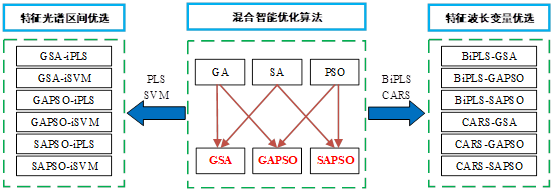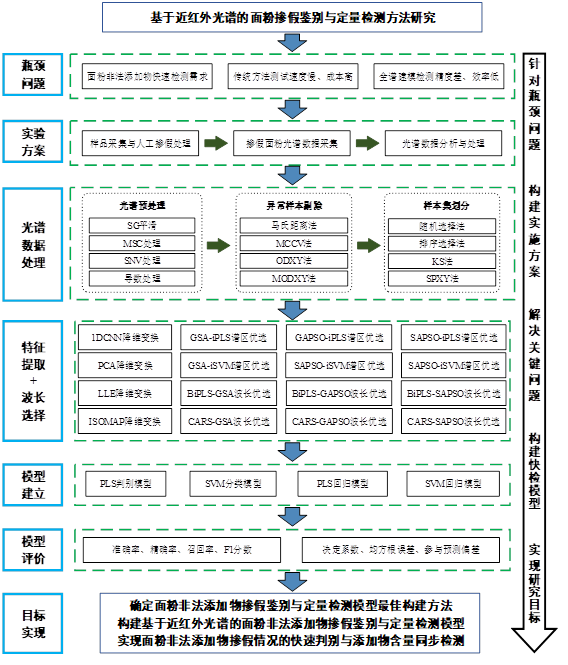1.NIRS在面粉掺假检测方面的应用现状
随着NIRS分析技术和化学计量学的发展,NIRS分析的应用领域得到进一步扩展,近年来相关人员在应用NIRS进行面粉非法添加物掺假快速判别与检测方面开展了一系列研究工作[9,10]。相关研究主要侧重于单一非法添加物的掺假鉴别与定量检测,多种添加物混合掺假检测刚刚受到关注[11]。
黑龙江大学的孙来军教授团队(2019)探讨了径向基函数神经网络与NIRS相结合进行面粉中滑石粉含量快速检测的可行性,采用相关系数法获取到59个最大相关信息波长变量建立了满足实际需求的快速检测模型[12]。孙教授团队(2022)还将遗传算法(genetic algorithm,GA)与其他波长选择方法相结合优选了NIRS波长变量,构建了不同种类面粉掺假滑石粉的快速检测模型[13,14]。加拿大麦吉尔大学的Ngadi等人(2021)研发了一种低成本、紧凑型手持式微型近红外光谱仪,用于面粉掺假不同品种木薯粉的快速鉴别,总体预测准确率达97.53%[15]。课题申请人团队(2022)将反向区间偏最小二乘(backward interval
partial least squares,BiPLS)与竞争自适应重加权采样(competitive adaptive
reweight sampling,CARS)相结合进行NIRS特征波长优选,获取到72个关键波长变量构建面粉掺假滑石粉定量检测模型[10]。巴西帕拉伊巴州联邦大学的Fernandes等人(2022)对比了NIRS和数字图像技术进行面粉掺假木薯粉的分类鉴别与定量检测性能,发现NIRS具有优于数字图像的面粉掺假鉴别与检测能力[9]。华中农业大学的江洋博士团队(2023)开展了基于NIRS的面粉中滑石粉和过氧化苯甲酰两种非法添加剂含量快速检测方法研究,发现CARS与随机蛙跳算法相结合优选特征波长的建模性能最佳[11]。
2.NIRS特征波长智能优选算法研究现状
随着NIRS分析技术与装备的发展,数据采集精度得到显著提高,光谱数据中包含的大量不相干和共线性冗余数据对特征波长优选提出了更高要求。特征波长优选包括特征光谱区间优选[16]和特征波长变量优选[17]两大类。相关学者在传统波长选择算法的基础上提出应用GA、模拟退火算法(simulated
annealing algorithm,SA)、粒子群优化算法(particle swarm
optimization,PSO)等智能优化算法进行NIRS波长变量组合优化,利用其强大的随机搜索能力有效解决光谱波长变量之间的共线性问题,并且还可以与其他波长选择方法相结合进行特征波长优选[18]。目前,光谱波长优选算法正朝着多种波长选择方法相结合的方向发展[19,20]。
浙江大学的史舟教授团队(2019)提出应用GA与区间偏最小二乘法(interval partial least
squares,iPLS)相结合进行土壤有机质和pH值NIRS特征光谱区间优选,并应用多种定量校正方法建立了满足检测需求的NIRS回归模型[21]。安徽农业大学的张正竹教授团队(2020)对比了GA、SA、PSO三种智能算法进行红茶NIRS特征波长变量优选的性能,发现PSO优选特征波长构建的红茶等级判别模型精度最高[22]。张教授团队(2021)还将改进的GA与PSO相结合构建了一种变量空间收缩优化策略优选NIRS特征波长,实现了滇红红茶品质快速判别[23]。贵州医科大学附属医院的牛玉林博士团队(2022)应用SA优选NIRS特征波长进行血清中脯氨酸含量定量检测模型的构建,取得了优于iPLS的建模精度[24]。吉林大学姚美宝博士团队(2022)将协同区间偏最小二乘(synergy interval
partial least squares,SiPLS)与GA相结合进行NIRS特征波长优选,建立了南果梨可溶性固形物和硬度的定量分析模型[25]。广东药科大学的孙悦教授团队(2023)应用NIRS进行了山楂果实的化学成分和抗氧化活性快速检测方法的研究,分别使用GA和PSO进行特征波长变量优选,构建了回归精度显著优于全谱的校正模型[26]。课题申请人团队(2023)针对单一智能算法自身存在的不足,尝试将两种智能算法进行融合改进设计构建混合智能优化算法,并将其与BiPLS和CARS相结合优选NIRS特征波长,成功应用于构建大米蛋白质和沼液氨氮定量检测模型[27,28]。
综上所述,在应用NIRS进行面粉单一非法添加物掺假鉴别与定量检测方面已经取得了较好的研究成果,但面粉多种非法添加物共同掺假的分类鉴别与同步定量检测方面鲜有报道,尚需开展进一步深入研究。GA、SA和PSO在NIRS特征波长优选方面已经展现出良好的性能,但其自身存在一定的缺陷,如GA存在早熟收敛、SA搜索效率较低、PSO的全局搜索能力较差。因此亟待对上述算法进行改进,并研究改进后的算法与其它波长选择方法相结合进行NIRS特征波长优选的可行性。将两种智能优化算法相结合进行优化设计,充分发挥各自优势的同时弥补其不足,是进行智能算法改进的主要策略之一。将GA、SA、PSO两两结合优化设计构建三种混合智能优化算法,解决单一算法不足的同时用于光谱特征波长高效智能优选,获取面粉多种非法添加物高相关性建模波长变量,阐明滑石粉、石膏粉、ADA等面粉非法添加物与NIRS特征波长的对应关系,构建满足实际检测需求的面粉掺假鉴别与定量检测模型,实现面粉非法添加滑石粉、石膏粉、ADA的快速鉴别和非法添加物含量的定量检测,为质检部门面粉掺假检测提供有效技术手段,为相关在线检测装备的研发提供理论支持。
参考文献
[1] 陈卫东, 刘超, 王莹, 等. 机器视觉在小麦粉加工精度检测中应用的研究进展[J/OL]. 中国粮油学报.
https://doi.org/10.20048/j.cnki.issn.1003-0174.000715
[2] N. Nisar, F. Mustafa, A. Tahir, et al.
Proximate composition, functional properties and quantitative analysis of
benzoyl peroxide and benzoic acid in wheat flour samples: effect on wheat flour
quality[J]. Peerj, 2020, 8: e8788.
[3] Hong-Yan Liu, Syed Abdul Wadood, Yu Xia, et
al. Wheat authentication:An overview on different techniques and chemometric
methods[J]. Critical Reviews in Food Science and Nutrition, 2023, 63(1): 33-56.
[4] 焦锡涛, 胡云, 张二豪, 等. 基于《中华人民共和国食品安全法》的食品添加剂现状研究[J]. 食品工业, 2023,
44(11): 334-337.
[5] 田林双, 顾鹏程, 吴存兵, 等. 小麦粉及其制品中偶氮甲酰胺检测方法研究进展[J]. 食品科学, 2021, 42(9):
347-354.
[6] H. J. He, Y. Chen, G. L. Li, et al.
Hyperspectral imaging combined with chemometrics for rapid detection of talcum
powder adulterated in wheat flour[J]. Food Control, 2023, 144: 109378.
[7] S. Zhang, S. Liu, L. Shen, et al. Application
of near-infrared spectroscopy for the nondestructive analysis of wheat flour: A
review[J]. Current research in food science, 2022, 5: 1305-1312.
[8] S. Shi, J. Feng, L. Yang, et al. Combination
of NIR spectroscopy and algorithms for rapid differentiation between one-year
and two-year stored rice[J]. Spectrochimica Acta Part A: Molecular and
biomolecular spectroscopy, 2023, 291: 122343.
[9] E. S. A. Duarte, V. E. de Almeida, G. B. da
Costa, et al. Feasibility study on quantification and authentication of the
cassava starch content in wheat flour for bread-making using NIR spectroscopy
and digital images[J]. Food Chemistry, 2022, 368: 130843.
[10] Changhao Bao, Changhao Zeng, Jinming Liu, et
al. Rapid detection of talc content in flour based on near-infrared
spectroscopy combined with feature wavelength selection[J]. Applied Optics,
2022, 61(19): 5790-5798.
[11] Shijie Shi, Junheng Feng, Yingying Ma, et al.
Rapid determination of two illegal additives in wheat flour by near-infrared
spectroscopy and different key wavelength selection algorithms[J]. LWT, 2023,
189: 115437.
[12] Y. I. Liu, L. Sun, Z. Ran, et al. Prediction of
Talc Content in Wheat Flour Based on a Near-Infrared Spectroscopy Technique[J].
Journal of Food Protection, 2019, 82(10): 1655-1662.
[13] C. S. Du, L. J. Sun, H. Y. Bai, et al.
Detection of talcum powder content in wheat flour by near infrared spectroscopy
based on multilevel feature selection[J]. Journal of Chemometrics, 2022,
36(11): e3451.
[14] C. S. Du, L. J. Sun, H. Y. Bai, et al.
Quantitative detection of talcum powder in wheat flour based on near-infrared
spectroscopy and hybrid feature selection[J]. Infrared Physics &
Technology, 2022, 123
[15] Feifei Tao, Li Liu, Christopher Kucha, et al.
Rapid and non-destructive detection of cassava flour adulterants in wheat flour
using a handheld MicroNIR spectrometer[J]. Biosystems Engineering, 2021, 203:
34-43.
[16] Chunting Li, Huazhou Chen, Youyou Zhang, et al.
Improvement of NIR prediction ability by dual model optimization in fusion of
NSIA and SA methods[J]. Spectrochimica Acta Part A: Molecular and Biomolecular
Spectroscopy, 2022, 276: 121247.
[17] Y. Zhao, Y. Zhu, C. Li, et al. Fast analysis of
straw proximates based on partial least squares using near-infrared
spectroscopy[J]. Spectrochimica acta. Part A, Molecular and biomolecular
spectroscopy, 2024, 309: 123855.
[18] S. Wang, L. Feng, P. Liu, et al. Digital
Prediction of the Purchase Price of Fresh Tea Leaves of Enshi Yulu Based on
Near-Infrared Spectroscopy Combined with Multivariate Analysis[J]. Foods, 2023,
12(19): 3592.
[19] G. Abrantes, V. Almeida, A. J. Maia, et al.
Comparison between Variable-Selection Algorithms in PLS Regression with
Near-Infrared Spectroscopy to Predict Selected Metals in Soil[J]. Molecules,
2023, 28(19): 6959.
[20] R. Falcioni, J. V. F. Gon?alves, K. M. de
Oliveira, et al. Chemometric Analysis for the Prediction of Biochemical
Compounds in Leaves Using UV-VIS-NIR-SWIR Hyperspectroscopy[J]. Plants, 2023,
12(19): 3424.
[21] M. Yang, D. Xu, S. Chen, et al. Evaluation of
Machine Learning Approaches to Predict Soil Organic Matter and pH Using vis-NIR
Spectra[J]. Sensors, 2019, 19(2): 263.
[22] G. X. Ren, Y. M. Sun, M. H. Li, et al.
Cognitive spectroscopy for evaluating Chinese black tea grades (Camellia
sinensis): near-infrared spectroscopy and evolutionary algorithms[J]. Journal
of the Science of Food and Agriculture, 2020, 100(10): 3950-3959.
[23] G. Ren, J. Ning, Z. Zhang. Multi-variable
selection strategy based on near-infrared spectra for the rapid description of
dianhong black tea quality[J]. Spectrochimica acta. Part A, Molecular and
biomolecular spectroscopy, 2021, 245: 118918.
[24] K. Zhu, S. Zhang, K. Yue, et al. Rapid and
Nondestructive Detection of Proline in Serum Using Near-Infrared Spectroscopy
and Partial Least Squares[J]. Journal of analytical methods in chemistry, 2022,
2022: 4610140.
[25] Yan Yu, Meibao Yao. A portable NIR system for
nondestructive assessment of SSC and firmness of Nanguo pears[J]. LWT, 2022,
167: 113809.
[26] T. Ye, Y. Zheng, Y. Guan, et al. Rapid
determination of chemical components and antioxidant activity of the fruit of
Crataegus pinnatifida Bunge by NIRS and chemometrics[J]. Spectrochimica Acta
Part A: Molecular and Biomolecular Spectroscopy, 2023, 289: 122215.
[27] Yonghua Xu, Jinming Liu, Yong Sun, et al. Fast
detection of volatile fatty acids in biogas slurry using NIR spectroscopy
combined with feature wavelength selection[J]. Science of the Total
Environment, 2023, 857(Pt 1): 159282.
[28] Jinming Liu, Xin Luo, Dongjie Zhang, et al.
Rapid determination of rice protein content using near-infrared spectroscopy
coupled with feature wavelength selection[J]. Infrared Physics &
Technology, 2023, 135: 104969.





